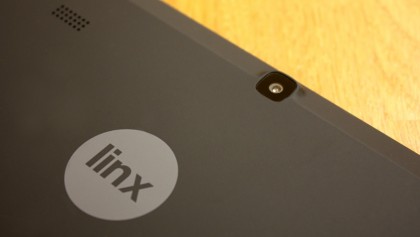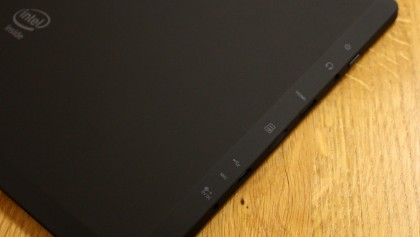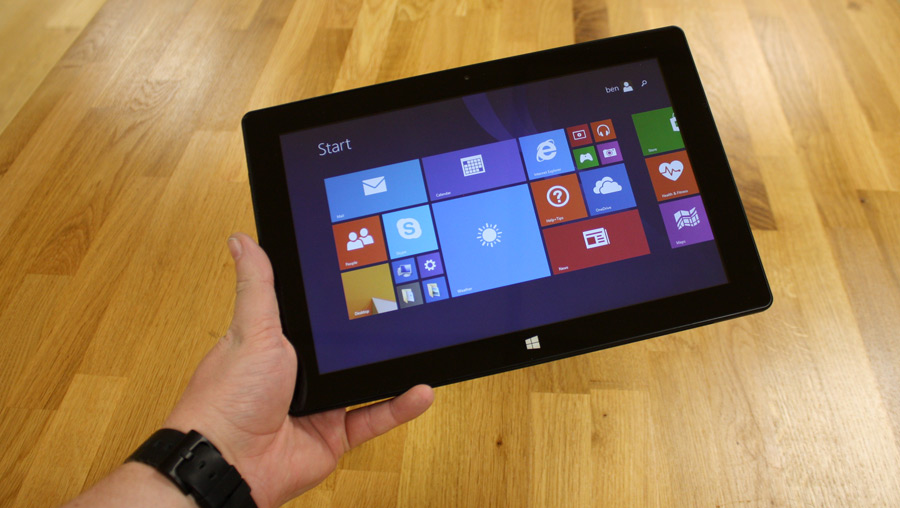Why you can trust TechRadar
Benchmarks
- 3D Mark: Fire Strike: would not run; Sky Diver: 318; Cloud Gate: 898; Ice Storm Unlimited: 11,223; Ice Storm Extreme: 6,178
- CineBench 11.5: CPU: 1.08 (multi), 0.29 (single); Graphics: 4.55fps
- PC Mark 8: Home Test: 1,014; Battery Life: 10 hours
Much like its 8-inch equivalent, the Linx 10 packs a passively-cooled quad-core Intel Z3735F Bay Trail-T Atom processor, but surprisingly – unlike the smaller sibling – it actually idles at a lower clock speed of 1.33GHz, bursting to speeds of up to 1.83GHz. It's exactly the same processor that features Gen7 architecture with Intel HD graphics that support DirectX 11, despite being clocked at a lowly 646MHz. In a step up from the similar Schenker Element 10.1 and Linx 8, the Linx 10 doubles the RAM from 1GB of LPDDR3 up to 2GB.

This means – above all else – that whilst it may be no more powerful in some respects, the marginally newer processor and additional RAM does show better performance in multi-tasking and some memory-intensive applications.
Onboard storage is available in either 32GB or 64GB varieties – I reviewed the 32GB version, which comes with 24GB out of the box, but only a little over 17GB available for storage. It's very easily filled if you start installing fully-fledged applications. I managed to run out of space simply by installing the suite of benchmarking software I needed to use for this review. Of course, you can equip the Linx 10 with a microSD card of up to 64GB for a plentiful amount of extra storage, should you require.

Screen quality is surprisingly good, if a little low-resolution. The 1,280 x 800-resolution, 10.1-inch panel makes use of IPS technology, which ensures good brightness, contrast and viewing angles, but the resolution feels a little limiting when viewing detailed web pages.
Turned up to the maximum brightness, the panel manages a pretty impressive 329cd/m2, but at this brightness, expect the battery life to easily run out around the six hour mark.
With the brightness turned down to about a third, it measures 120cd/m2, and at this point can easily break the 10 hour battery life marker – more than the quoted maximum of eight hours. Whilst the display is bright with good contrast, colour accuracy is not as good as I have seen on other tablets with IPS screens, with videos and photos lacking the vivid punch we've come to expect from AMOLED panels.
As I've found with most other cheaper Windows tablets, despite featuring a 64-bit Atom processor, the version of Windows 8.1 onboard is limited to 32-bit applications, meaning it doesn't entirely make full use of the CPU's capabilities. It's an odd decision, and likely to be largely down to cost saving more than anything else.
Sign up to the TechRadar Pro newsletter to get all the top news, opinion, features and guidance your business needs to succeed!
Where benchmarks are concerned, the Linx 10 was a bit of a let-down compared to the Linx 8. The lower clocked processor meant that visual quality and the framerate on 3D Mark and Cinebench's OpenGL test noticeably suffered, whilst Cinebench's CPU tests and PC Mark scores were also lower, and only propped up by the additional RAM on offer.

Bundled software
As you may have come to expect with the current generation of low-end Windows tablets, a year of Microsoft's Office 365 is pre-installed, meaning that the tablet can be used as a genuinely productive PC.
Other than this single extra bundle of applications, there's nothing else save for the standard suite of Windows accessories pre-installed. Of course, you can head to the Windows Store to find additional applications, but nearly three years after Windows 8 was first introduced, the selection is – at best – a relatively uninspiring affair.
Linx does offer 1TB of OneDrive storage, but I could find absolutely no details as to how long this cloud storage offer would remain in place. The company also advertises a £50 (around $74, or AU$96) cashback incentive when you trade in your old tablet, but on closer examination, this offer expired on March 31 on all but the 8-inch model (for which you'll get £30 – around $45, or AU$58).
